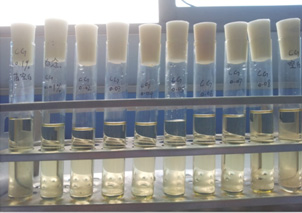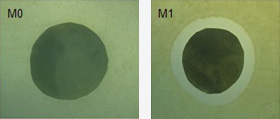Microbial Limit Test
Ⅰ Purpose
A test used to evaluate the effectiveness of antibacterial products in inhibiting the growth of bacteria in vitro, also called an antibacterial test. Through this experiment, the minimum inhibitory concentration can be determined to evaluate the antibacterial performance of the product. This is the most basic efficacy data for antibacterial products.
Ⅱ Strain selection
The bacterial species recommended by the CTFA are very representative. They have passed the microbiological challenge test according to the CTFA standard and have a 3-year shelf life recognized worldwide.
| Category |
Name |
Attributes |
Features |
Potential threat to the skin |
| Bacterial |
E.Coli |
Gram Negative |
Fermented lactose produces acid and gas, aerobic or facultative anaerobes |
Cause secondary skin infections |
| S.Aureus |
Gram Positive |
Plasma coagulase positive, acid but not gas, aerobic or facultative anaerobes |
Causes severe skin burn-like dermatitis symptoms such as empyema, folliculitis, and furuncle |
| P.Aeruginosa |
Gram Negative |
Oxidase is positive, producing pyocyanin. It can also liquefy gelatin, reduce nitrate to nitrite, obligate aerobes |
Entering the eyes can cause purulent corneal ulcers, and entering the wounds can cause suppuration; barrier damage can cause skin infections; severely can cause sepsis |
| Fungus |
C.Albicans |
Yeast |
Can ferment to produce acid, secrete toxins, facultative anaerobic bacteria |
Causes skin allergic dermatitis and various fungal skin diseases |
| A.Niger |
Mold |
Mold produces mildew spots, has a musty odor, and is an aerobic fungus |
Causes skin allergic dermatitis and various fungal skin diseases |
Ⅲ Experimental method
Method 1. Micro Broth Dilution Method
Experimental Principle: MIC:The minimum concentration required to inhibit the growth of microorganisms. The antibacterial efficacy is judged according to the MIC value.
Experimental Procedure:Add the preservative to the liquid medium (such as broth), dilute the preservative into liquids of different concentrations by the serial dilution method, inoculate and cultivate the microorganisms, and observe the growth of the microorganisms.
Evaluation criteria:The concentration of preservative when the microorganisms are not growing is the minimum inhibitory concentration. The smaller the MIC value, the better the antibacterial effect of the substance.
A
M0 On behalf of the broth, add preservatives and bacterial liquid before co-cultivation
M1 On behalf of after to cultivating, the solution is clear after the preservative concentration is greater than 0.06
Result Analysis: The MIC value of this product is 0.06
Method 2. Paper diffusion method (K-B method), E test-inhibition zone test, inhibition zone test
Experimental Principle:It is the simplest experimental method to evaluate the antibacterial effect of a preservative, and the antibacterial effect is judged according to the size of the inhibition zone.
Experimental Procedure:The test bacteria or mold can grow vigorously after being cultured on a suitable medium. If a filter paper disc treated with preservatives is placed in the center of the medium plate to penetrate the surroundings, a zone of inhibition can be formed. Measure the diameter of the inhibition zone, you can judge the effectiveness of the preservative.
Evaluation Criteria:The larger the diameter of the inhibition zone, the better the effectiveness of the preservative.
-
B
M0 No zone of inhibition
M1 Obvious zone of inhibition
Result Analysis: The antibacterial effect of M1 is significantly higher than that of M0
M0 has no or very poor antibacterial effect
-
C
M0 has no or very poor antibacterial effect
M1 Antibacterial and sterile
Result Analysis: M1 has a significantly higher antibacterial effect than M0
M0 has a very poor antibacterial effect
Microbial Identification Test
The contamination of cosmetics by microorganisms not only affects the quality of the product, but also endangers the health and safety of consumers. Therefore, all countries in the world attach great importance to it. All countries have formulated hygiene standards for microorganisms in cosmetics. The contamination of microorganisms in cosmetics is regarded as a quality indicator of products. The second indicator of microorganisms in cosmetics in various countries is that cosmetics must not contain pathogenicity bacteria.
The definition of pathogenic bacteria should be very clear in microbiology, but the bacteria included in its connotation are very broad. In the indicator of microorganisms in cosmetics, the pathogenic bacteria referred to include pathogenic bacteria and conditional pathogens.
-
The specific bacteria specified by the World Health Organization are two species: Pseudomonas aeruginosa and Staphylococcus aureus.
-
There are three specific bacteria in some European countries: Pseudomonas aeruginosa, Staphylococcus aureus, and Escherichia coli.
-
The specific bacteria stipulated in our country are three kinds: Pseudomonas aeruginosa, Staphylococcus aureus, and fecal coliform.
-
Japan stipulates three specific bacteria: Pseudomonas aeruginosa, Staphylococcus aureus, and coliform.
-
The United States specifies 10 species of specific bacteria: Pseudomonas aeruginosa, Staphylococcus aureus, Escherichia coli, Klebsiella, Salmonella, Proteus, Pseudomonas maltophilia, Pseudomonas polytrophic, and non-sentinel Motion Bacteria, Serratia marcescens.
Ⅰ The Guangmann Institute of Microbiology has a complete strain library, and uses a variety of identification methods to help customers identify strains.
-
A.Routine Identification
Routine identification content has morphological characteristics and physical and chemical characteristics. Morphological characteristics include microscopic morphology and culture characteristics: physical and chemical characteristics include nutrient type, carbon and nitrogen source utilization capacity, various metabolic reactions, enzymatic reactions and serological reactions.
-
B.API
The API identification system covers 15 identification series, with about 1,000 biochemical reactions, and currently more than 600 types of bacteria can be identified. During the identification process, an appropriate physiological and biochemical identification series can be selected according to the group of bacteria, and the bacteria to be tested can be compared with the database through software to obtain identification results.
Ⅱ Microbial Treatment Solutions and Corporate Disinfection Services
Guangmann has its own microbiology laboratory R&D and testing team, in line with the mission of "PROVIDING THE BEST FOR BEAUTY", providing professional and high-quality disinfection treatment services.
A. Trace the Source of Microbial Infection
Routine identification content has morphological characteristics and physical and chemical characteristics. Morphological characteristics include microscopic morphology and culture characteristics: physical and chemical characteristics include nutrient type, carbon and nitrogen source utilization capacity, various metabolic reactions, enzymatic reactions and serological reactions.
B. Long-Term Microbiological Monitoring
According to the different microbial pollution problems that occur in the production process of customers, we use strain separation, purification and identification technology to identify strains, sample and analyze the production site and original packaging materials, investigate pollution sources, and provide for the suppression of contaminated strains and elimination of pollution sources different solutions. In addition, the factory's production environment, air, equipment, and water supply systems are routinely disinfected to provide a good production environment for the factory. Minimize the risk of microbial contamination and provide customers with the most assured service.





















